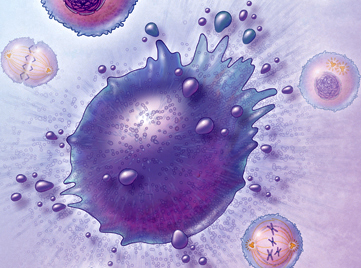Beating Stress
With finals week approaching, stress levels are at an ultimate high. Stress can manifest in physical and psychological symptoms such as headache, impaired concentration, and change in eating and sleeping habits, which are all factors that can negatively impact one’s performance. Methods to manage anxiety during this stressful time include getting enough sleep, having a stress outlet, finding an effective study strategy, exercising, and taking short breaks from studying. Besides these strategies, studies have shown that listening to music is also an effective way of reducing stress.
In response to stress, the adrenal gland releases a hormone called cortisol as part of the fight-or-flight mechanism. Cortisol regulates blood pressure and the immune system, allowing the body to spend more energy on other functions. In times of prolonged stress, high cortisol levels can cause sleep abnormalities and reduced immune response, as well as interfere with learning and memory.
Chanda and Levitin analyzed the results of up to 400 studies to determine the effects of music on stress. In one study, researchers simulated stressful situations associated with school and work and measured subjects’ levels of stress at different times, post-stressor. They found that the cortisol levels for subjects who listened to relaxing music lowered at a quicker rate than the silent control. Another study involved patients who were about to undergo invasive surgery. Patients were randomly assigned to either listen to music or to take anti-anxiety drugs. Participants were asked to rate their own anxiety and researchers measured levels of cortisol. Results showed that the group that listened to music had lower cortisol levels than the group that took anti-anxiety medication.
In addition to having positive effects on the psychological stress response, music has also been shown to improve the autonomic nervous system’s response to stress. A study by Thoma et al compared the effects of different sounds on the level of stress. The three different conditions included relaxing music, the sound of rippling water, and a control with no acoustic stimulation. The salivary cortisol and alpha-amylase, heart rate, respiratory sinus arrhythmia, and subjective stress and anxiety perception were measured repeatedly. Researchers found that after the stressor, the salivary alpha-amylase baseline values were reached at a much faster rate for participants who listened to relaxing music compared to participants who did not have any acoustic stimulation.
In conclusion, simply listening to relaxing music can be a very effective way of reducing stress and avoiding the negative symptoms that can decrease productivity during this last week of the semester.
~ Sophia Hon
Sources:
Surviving Stress and Anxiety in College and Beyond
The Effect of Music on the Human Stress Response
Image by CDC [Public domain], via Wikimedia Commons
The Neuroscience Involving Habits
A habit is behavior that becomes automatic after regular repetition. The pervading thought used to be that habits are formed to free the brain, so it may perform other tasks, and to an extent, that is still true. However, a recent study conducted by MIT neuroscientists has found that a small region of the prefrontal cortex, where most thought and planning occurs, is devoted to controlling habits – deciding which habits are switched on at a given time. In addition, the study shows that although habits may become deeply engrained, the brain’s planning centers can shut them off.
In order to simulate engrained habits, the MIT team trained rats to run a T-shaped maze. As the rats reached the turning point of the maze, they were given a tone indicating whether to turn left or right; when they chose correctly (turning left), they received a reward of chocolate milk and when they chose incorrectly (turning right), they received only sugar water. Showing that the rats were displaying a fully engrained habit, the researchers stopped giving the rats any rewards; the rats continued to run the maze correctly. The scientists also offered the rats chocolate milk mixed with lithium chloride, which causes light nausea; the rats stopped drinking the chocolate milk yet still turned left.
Then the researchers tried to see whether or not they could break the rats’ habit to run left by interfering with activity in the infralimbic (IL) cortex, a part of the prefrontal cortex. Although the neural pathways that encode habits are located in the basal ganglia - a set of deep brain structures involved in coordination of movement, cognition, and reward-based learning - it has been shown that the IL cortex is also necessary for such behaviors to develop. The researchers, using optogenetics, a technique allowing researchers to inhibit certain cells with light, turned off IL activity in the rats’ brains as they approached the turning point. As a result, the rats turned right (where the reward was now located) and later formed the habit of turning right even when cued to left. Inhibiting IL activity again, researchers found that the rats’ regained their original habit of turning left when cued to do so.
From the results of the study, the researchers found that the IL cortex is responsible for determining which habits are expressed, and that it favors new habits over old ones; habits are broken but not forgotten when replaced. The results offers hope for those suffering from disorders involving overly habitual behavior, such as obsessive-compulsive disorder.Although it would be too invasive to use optogenetic interventions to break habits in humans, the technology could potentially evolve to a point where it would be a feasible option for treatment.
~ Nathaniel Meshberg
Sources:
Understanding How Brains Control our Habits
Does Thanksgiving Turkey Really Make You Tired?
Thanksgiving traditions tend to vary from house to house, but one thing seems to remain constant: turkey. We stuff ourselves with turkey and (possibly) cranberry sauce, as if its our last supper. A common desire after eating is to nap - as if eating is a strenuous activity. A well known explanation for this is that the turkey we eat is high in tryptophan, which makes us sleepy; is this true?
What is tryptophan? It is an amino acid obtained through the diet, and is found in all poultry. This amino acid is a precursor to the neurotransmitter serotonin, which plays a role in mood regulation and relaxation. Serotonin is also a reagent in the synthesis of melatonin, a hormone which controls sleep cycles. In theory, this would explain why eating turkey could induce a certain sense of drowsiness.
However, because other types of poultry do not induce this same sensation, despite the fact that they may house larger amounts of tryptophan, the above explanation is implausible. It turns out that foods rich in tryptophan need be accompanied by foods high in carbohydrates to affect serotonin levels. Carbohydrates help transport the fairly bulky tryptophan across the blood-brain barrier so that it can regulate serotonin levels. Therefore, eating stuffing, potatoes, yams, or any other form of carbohydrate together with turkey during Thanksgiving dinner is what increases the serotonin level.
The main cause of grogginess after a hearty Thanksgiving meal is overeating. Overeating causes the digestive system to use more energy than it usually would, resulting in a sense of light fatigue. Between this, the alcohol (a central nervous system depressant) and family drama, of course you'd be ready for bed! As it turns out, the turkey, and therefore the tryptophan, is not the only culprit of this Thanksgiving feast fatigue - your third serving is too!
So the lesson here is...everything in moderation (including turkey).
~ Alexa Aaronson
The Truth about Tryptophan: http://www.webmd.com/food-recipes/the-truth-about-tryptophan?/page=3
Thanksgiving Myth Busted: Eating Turkey Won't Make You Sleepy: http://www.livescience.come/41542-thanksgiving-myth-busted-eating-turkey-won-t-make-you-
Does Eating Turkey Make You Sleepy? http://chemistry.about.com/od/holidaysseasons/a/tiredturkey.htm
Winter Blues or PMS?
Women have a pretty bad rep when it comes to hormones. We get it all the time, in memes, as jokes in TV shows, or in the form of the amusing side comment, “It’s that time of the month again, eh?” with a crass wink. Yes yes, females have a tendency to be moody. For whatever reason, this is a theme present throughout our genetic makeup. A recent study conducted at Indiana University shows that seasonal changes, particularly the fall to winter transition, are associated with a rise in aggressive behavior in female hamsters as opposed to male hamsters. This study revealed new mechanisms by which sex hormones are influenced by the nervous system and provides a model from which we can further study the male and female nervous systems.
The experimenters singled out melatonin as the hormone stimulating female adrenal glands to release hormones acting in place of the hormones released from the gonads. Things do not work this way for male hamsters when there’s a change of season. In females, they found some strange things about this system. The adrenal glands normally release an aggression hormone, DHEA, in response to the release of another hormone, ACTH, secreted by the pituitary gland. Once this seasonal change kicks in however, melatonin is the hormone that stimulates the release of DHEA, and it completely skips past the pituitary gland.
One group of hamsters in this experiment was exposed to the shorter day conditions of winter for ten weeks and then observed for aggressive behaviors. Not only were the female hamsters more aggressive than the males and the control group, but their chemistry had also changed. These aggressive ladies had higher levels of DHEA and melatonin in their bloodstreams and also displayed physical changes in their adrenal glands.
Given that hamsters happen to have similar adrenal systems to humans, these results give us much greater insight into how our own adrenal systems function and how they could be affected throughout the year. While it hasn’t been experimentally proven that these findings can be applied to humans as well, I think it definitely explains away my aggressive feelings during the cold dark months.
~ Jackie Rocheleau
http://www.sciencedaily.com/releases/2015/11/151118070754.htm
http://rspb.royalsocietypublishing.org/content/282/1819/20152080
Neuroscience and the Greatest Minds
The Pyramids of Giza is one of “the Seven Wonders of the World,” which required Ancient Egypt to utilize complex knowledge in mathematics and architecture to figure out how to construct such landmark from the beginning. Some beholders are in such disbelief that they believe a greater force than the ancient civilizations built it for unknown purposes. However, with the understanding of the human mind, we can tell that the Egyptian scholars and builders were at least smart and strong enough to build such awesome necropolis.
One of the key requirements to stay active, smart, and diligent is basically to stay healthy. One of the most important ways to stay healthy is through physically fitness. Cardiovascular exercise is high priority because evolutionarily our ancestors for the majority of the time used their legs to migrate and that part of the body was mostly used to keep the body running. Our brains are like computers where we need activities that grant us gratification to maintain our stress levels and keep the brain stimulated lengthening life-span and heightening mental and physical performances. Stress levels in fact cause much harm to our brain and body impairing our mental performances and immune systems.
One difference between a university student and ancient Egyptian scholar would most likely be how much each sit down and walk during recreational hours. No one would deny that our changes in technology greatly altered how much we sit to play with our computers as opposed to play sports outside the day for fun. Sitting in fact causes much harm to our health making us more prone to becoming lazy and corpulent which would make the ancient Egyptian scholars have greater capabilities if they were to exist in our time. Those scholars most likely had more fun playing sports that break their sweats since no monitors were there to drain their mental and physical health. But in reality, if we fight our tendency to be lazy and exercise as much as those of the ancient times, we would probably be valedictorians in the first-tier schools, earn six-digit salaries in great careers, create great achievements, and live much longer without any chronic diseases.
~ Dong Jun Yoo
Works Cited
"Are You Sitting Too Much?" YouTube. YouTube, n.d. Web. 17 Nov. 2015.
Medina, John. Brain Rules: 12 Principles for Surviving and Thriving at Work, Home, and School. Seattle, WA: Pear, 2008. Print.
"The Science of Laziness." YouTube. YouTube, n.d. Web. 17 Nov. 2015.
"The Upside of Isolated Civilizations - Jason Shipinski." TED-Ed. N.p., n.d. Web. 17 Nov. 2015.
How Dreams Are Shown Through Brain Activity
For the longest amount of time, sleep and dreams were a complete mystery. At best, only educated guesses could be made as to how and why we dream from scientists such as Sigmund Freud, who claimed that sleep was a “safety valve” for unconscious desires. Essentially, no concrete theory for the process of sleep could be made because scientists lacked the means of actually accessing the brain. In the 1950s, however, scientists made a breakthrough in the study of sleep when they discovered its various stages.
In 1953, researchers using electroencephalography (EEG) were able to measure human brain waves during sleep. In addition, they measured the movements of the limbs and eyes. From the results of these experiments, researchers were able to find that brain activity both increases and decreases during sleep. During the first hour of sleep, brain waves slow down, and the eyes and muscles relax. Heart rate, blood pressure, and temperature fall as well. Over the next half hour, however, brain activity drastically increases from slow wave sleep to rapid eye movement (REM) sleep, and brain waves observed during REM are similar to those observed during waking. As opposed to waking, however, atonia occurs, which is when the body’s muscles are paralyzed; the muscles that allow breathing and control eye movements are fully active, and heart rate, blood pressure, and body temperature increase. As sleep continues, the brain alternates between periods of slow wave sleep (divided into four stages, with brain activity increasing with each stage) and brief periods of REM sleep, with the slow wave sleep becoming less deep and the REM periods more prolonged until waking occurs. Approximately 20 percent of our total sleep is spent in REM sleep.
While dreams can occur during slow wave sleep, if one is awakened during its several stages, one will most likely recall only fragmented thoughts. Instead, most active dreaming occurs during REM sleep, when the brain is most active. During REM sleep, signals from the pons travel to the thalamus, which relays them to the cerebral cortex, the outer layer of the brain, and stimulate its regions that are responsible for learning, thinking, and organizing information (the pons also sends signals that shut off neurons in the spinal cord, causing atonia). As the cortex is the part of the brain that interprets and organizes information from the environment during consciousness, some scientists believe dreams are the cerebral cortex's attempt to “find meaning in the random signals that it receives during REM sleep.” Essentially, the cortex may be trying to interpret these random signals, “creating a story out of fragmented brain activity.”
~ Nathaniel Meshberg
Sources:
http://www.ninds.nih.gov/disorders/brain_basics/understanding_sleep.htm#dreaming
http://www.brainfacts.org/sensing-thinking-behaving/sleep/articles/2012/brain-activity-during-sleep
Conformity
Conformity is determined by a variety of situational and individual difference factors. Situational factors tend to increase when subjects are in groups that have been previously successful, when subjects are asked to give public responses while facing an opposition, when the stimuli are ambiguous or difficult, or when members are interdependent or unanimously opposed. Individual difference factors tend to increase when there are factors that decrease the subject’s certainty of their response or increase the subjective correctness of the group. (Back et al, 1965)
The behavior of conformity can be classified by whether someone’s behavior demonstrates a real acceptance of the norm, or whether the person is just going along with the group (Mezzacappa, 1995). The Asch conformity experiments in 1956 studied how participantswere influenced by conformity when they held an opinion that labeled them as the minority against a unanimous group opinion on unambiguous perceptual stimuli. The line judgment task in this experiment showed a standard line and comparison lines, and participants were asked to say the letter of the comparison line that matched the standard line out loud after hearing other people’s responses. Only 25% of the participants in the study gave correct answers after hearing other people’s erroneous answers. The study found that participants conformed due to either informational influence, which is the assumption that the crowd, or majority, must be correct, and the individual, or minority, must be wrong, or normative influence, which is the conformation to a crowd to avoid looking foolish. Personality characteristics relevant to deviation from norm can also be associated with conformity. Maslach (1974) and Maslach, Stapp, and Santee (1987) studied the trait of individuation and found that it is negatively correlated with conformity. Conformity behavior is also negatively correlated with intellectual achievement, perceptiveness of self, and security in social status. However, situational factors have a greater influence on conformity because individual difference factors tend to be more consistent.
~ Sophia Hon
Citations:
Back, K. W., Davis, K. E. (1965). Some personal and situational factors relevant to the consistency and prediction of conforming behavior. Sociometry, 28(3), 227-240.
Mezzacappa, E. S. (1995). Group cohesiveness, deviation, stress, and conformity.Dissertation Abstracts International: Section B: The Sciences and Engineering, 55(11), 5126.
The Paradox of Cell Death
“Apoptosis” is Greek word that literally means “falling of the petals from a flower or leaves from a tree” [1]. This description contrasts with the typical textbook definition: apoptosis is programmed cell death, caused by the Diablo gene. The literal translation stresses the evolutionary significance and benefit of apoptosis. While apoptosis can be detrimental, it is also important to understand the reason why nature would select for such a seemingly negative process that in fact has its benefits.
Apoptosis is important for maintaining a balance between cell proliferation and cell death. Families of proteases called caspases are responsible for cell death. Initiator caspases activate other executioner caspases, which continue to activate other executioner caspases. The Bcl2 family of proteins can either activate or deactivate caspases. Specifically Bax and Bak facilitate cell death because they cause cytochrome C to be released, leading to the assembly of the apoptosome. Another process for cell death is called necrosis - when a plasma membrane ruptures thus spreading the contents of the dying cells. This is different from apoptosis because typically phagocytes recognize cells undergoing apoptosis and engulf the cells and its contents, thus preventing them damage to other surrounding cells [2].
A protein relevant to apoptosis is the transcription regulator protein p53, which codes for a CDK inhibitor protein called p21 (a Cdk inhibitor protein). In response to DNA damage in the G1 phase of the cell cycle, p53 levels increase and the generated p21 binds to the G1/S-CDK to stop the cell from reaching the S phase. In cases where DNA damage cannot be repaired, p53 causes apoptosis because it is better for the cell cycle not to proceed with the damaged DNA. If p53 is nonfunctional, this has serious consequences for the cell because its leads to the replication of damaged DNA, leading to mutation and the generation of cancerous cells [2]. I find it astonishing that an issue with the expression of one protein, in this case p53, can lead to development of life-threatening diseases like cancer.
Furthermore, apoptosis plays an interesting role in Alzheimer’s disease (AD). AD is caused by AB plaques, which are aggregates of a misfolded version of the amyloid precursor protein (APP). AB is generated when APP is cleaved by B-secretase (or BACE) in the amyloidogenic pathway. Current research shows that the death of neuronal and glial cells in the cerebral cortex and hippocampus is related to the cognitive decline that is characteristic of AD [3]. Only part of this neuronal cell death is caused by apoptosis, meaning the rest is mediated by necrosis and other different forms of apoptosis. Research implies that Bak and Bad rather than Bax (a part of the Bcl2 family) [3], therefore a potential AD treatment could involve a method for inhibiting the expression of Bak/Bad.
Cancer can be caused by a lack of apoptosis in harmful cells, thus allowing them to proliferate and cause tumors. Interestingly, the p53 gene is found in half of all human cancers [2]. Typically in tumors scientists have observed that the main regulators of the cell cycle are altered, thus impacting aspects of proliferative control such as cell cycle checkpoints and how the cell responds to DNA damage. Therefore, a possible cancer treatment could involve finding a way to induce tumor-selective cell death. However, a challenge with this approach is finding a way to do so without harming normal cell function or normal cell homeostasis [4]. If scientists could discover a molecule specific to tumor cells or molecules that are regulated differently in tumor cells than in normal cells, this approach could be potentially beneficial.
~ Srijesa Khasnabish
Sources
[1] Zhivotovsky, B (2002) From the Nematode and Mammals Back to the Pine Tree: On the asdfasdfDiversity and Evolution of Programmed Cell Death Cell Death and Differentiation 9, asdfasdf867-869 doi:10.1038/sj.cdd.4401084
[2] Alberts, Bruce (2014) Essential Cell Biology. New York: Garland Science
[3] Shimohama, S (2000) Apoptosis in Alzheimer’s Disease - An Update Apoptosis 5, 9-16
[4] Kasibhatla S, Tseng B (2003) Why Target Apoptosis in Cancer Treatment? Molecular asdfasdfCancer Therapeutics 2, 573
Free Will
Most people believe that they have complete control over every conscious decision that they make. However, research shows that in some cases, conscious decision follows the onset of neural activity preceding a voluntary, self-initiated movement or task. In an experiment published in 1983, the recordable cerebral activity, or readiness-potential, that precedes voluntary motor acts was compared to the time that subjects reported an intention to act. Subjects were asked to recall a “clock position” of a revolving spot when they became aware of their intention to move. The time of the conscious decision was then compared to the actual time of the movement shown on the electromyogram recorded from the muscle and the time of the readiness-potential that was recorded simultaneously. Results indicated that neural activities consistently begin before a conscious intention to act (Libet et al, 1983).
A more recent experiment investigated neural activity involved in more complex, non-motor tasks. In this experiment, subjects were asked to freely choose between adding and subtracting. A continuous stream of stimulus frames was used to map the timing of their decisions and responses. As soon as the subjects felt the urge to perform their chosen task, they first memorized the letter on the frame, and then performed either addition or subtraction with numbers presented on the two following frames, and picked their answer on the fourth frame. Results showed that the free decision to add or subtract could be interpreted from neural activity in the medial prefrontal and parietal cortex up to four seconds before the subject was consciously aware of making a decision. The fMRI showed an overlap between the choice-predictive signals in the different neural processes involved in performing motor acts and mental tasks that indicates a common point in the brain responsible for different types of decision-making (Soon et al, 2013). So if the human brain can begin preparations for spontaneous, voluntary movements before a person is conscious of making a decision to move, does free will really exist?
~ Sophia Hon
Sources:
http://brain.oxfordjournals.org/content/brain/106/3/623.full.pdf
https://dl.dropboxusercontent.com/u/1828618/PredictingAbstractIntentions.pdf
Language and the Child’s Brain
You may have heard that it is a good idea for children to learn more than one language at a young age (especially toddlers) and that children learn languages more easily than adults. Why is it though, that learning early is advantageous for children? And is the claim that it is easier for children to learn languages than it is for adults true?
Like any other muscle, the more the brain exercises, the stronger it becomes. One way to strengthen the brain is by learning a language, memorizing rules and vocabulary. Research shows that children who learn additional languages have more creativity and flexibility and also possess better critical thinking skills compared to their non-foreign language learning peers, as these children outperform their peers in both verbal and mathematics standardized testing. Children should also learn more than one language because the brain is more open to new sounds and patterns at a young age, so children can mimic new sounds and adopt pronunciations more easily than adults.
Now, whether or not children learn language more easily than adults is up for debate. According to the much-debated “critical period hypothesis,” language development is similar to other forms of development, such as visual development, in that it has a critical period. At this critical period between childhood and adolescence, children can easily learn language, but when this period ends, learning becomes more difficult. Also, if a child fails to learn any language during this period, then the child’s capacity to develop language is permanently damaged and the neural basis for language development degenerates. Since this is only a hypothesis with limited evidence, whether or not this critical period actually exists is unknown. In any case, it certainly can’t hurt for a child to learn more than one language early and receive the clear mental benefits as a result.
~ Nathaniel Meshberg
Sources:
http://www.telegraph.co.uk/education/educationopinion/11151726/Children-should-start-learning-languages-at-age-three.html
http://www.forbes.com/2005/10/19/chomsky-noam-language-learning-comm05-cx_de_1024chomsky.html









